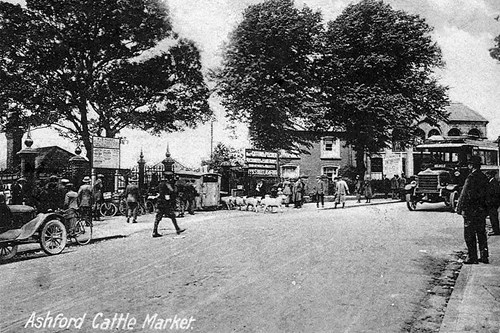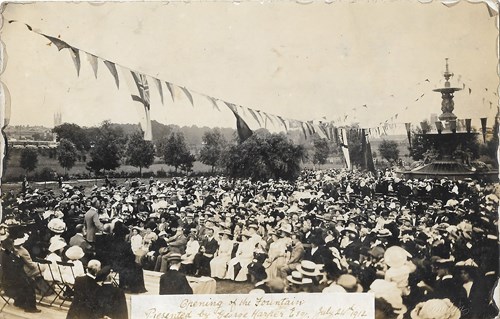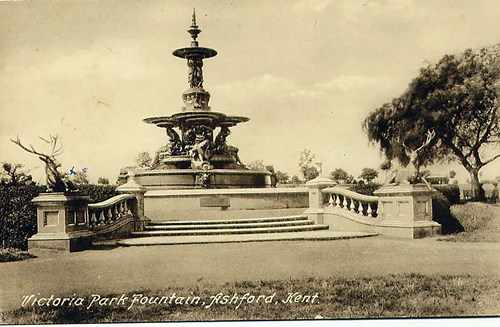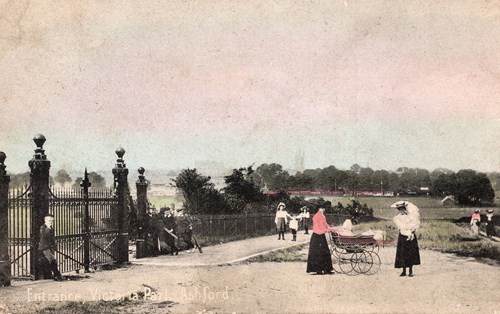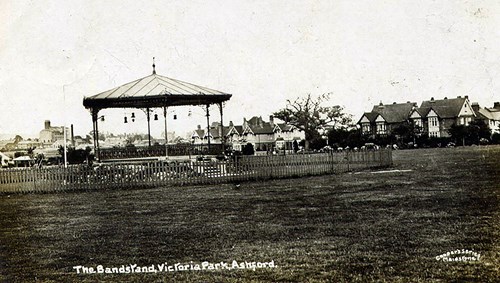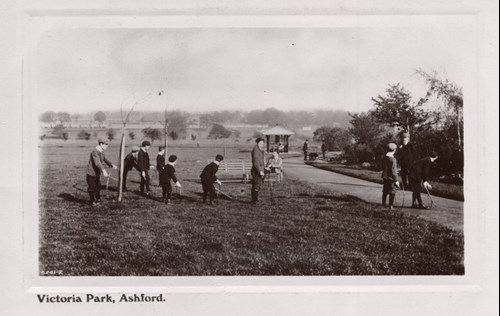Victoria Park Heritage
Until 1898, the land on which Victoria Park and Watercress Fields are now situated was a mixture of arable, pasture and orchard fields. The farmland also acted as a droving route from neighbouring farms through to the market in the town centre.
The Victoria Park land was owned by the Jemmett family, a well-known Ashford family who were responsible for a number of changes in the town and contributed significantly to its development.
In 1898, William Francis Bond Jemmett sold the first 17 acres of land to the Urban District Council for £2,780.00 to build the town’s municipal park. The surrounding residential streets which emerged through later developments are named after the Jemmett family as a result.
The park was formally designated as Victoria Park in October 1899. The park featured a bandstand, recreation ground, pond, extensive new trees and shrubs, shelter and changing rooms, and became a key place within the town to play sports matches and host public events.
Drovers’ route to Ashford market
An important drovers’ route used to run through Victoria Park, to the original market on Lower High Street and later, Elwick Road. Drovers’ routes were used for herding livestock to market or between summer and winter pastures. Livestock was usually herded on foot or horseback, and these roads were often up to 27 metres wide to fit large herds.
The drovers’ route dates back to the Middle Ages and would have been very busy; Ashford had been a prominent market town since the 1780s. In 1856, The Ashford Cattle Market Company Ltd was founded and it ran a cattle market at Elwick Road until 1998, when it moved to Orbital Park due to the construction of the Channel Tunnel Rail Link.
In the late 19th and early 20th century, transportation on the railway was introduced, and droving started to decline. It is no longer used for droving, but you can still follow the drovers’ footsteps down Jemmett Road and to the site of the original market.
There is also evidence to suggest that animals like sheep and cattle grazed in Victoria Park until at least 1919. Livestock grazing is likely to have stopped soon after the war as the cattle at nearby Watercress Farm were sold off in 1950.
Cattle Market, Elwick Road, 1925, postcard. Image courtesy of Ashford Museum.
The Hubert Fountain
Grade II* listed Hubert Fountain was created to showcase the work of the French ‘Val d’Osne foundry’ at the International Exhibition of 1862. The fountain is of typical mid-19th century design, with a pyramidal arrangement of cast iron gods, goddesses and cherubs, rising out of a surrounding basin. It was exhibited in the Royal Horticultural Society Gardens in South Kensington, London and was said to be a fine monumental work.
After the exhibition, the fountain was purchased by Major Erle-Drax, along with two cast-iron stags, to sit among the gardens of his family home, Olantigh Towers in Wye. He paid £3,000 which is £405,000 today!
Unfortunately Olantigh Towers burned down in 1903. It was at this point that the Earl-Drax family began selling the house’s contents and assets, and the fountain became available.
In 1910, local antiques dealer and philanthropist Mr Harper bought the fountain from Erle-Drax. He wanted to offer it as a gift to Ashford, the town he loved. However, the Council initially refused this gift as the installation costs were too high. Following a period of negotiation, Mr Harper agreed to pay for the installation on the condition it was turned on every 23 July to celebrate his birthday.
It has lived in Victoria Park in Ashford ever since and has been restored twice by Ashford Council: first in 1977 to mark the Queen’s Silver Jubilee, and again in 1998 following an award from the National Lottery Fund.
Fountain Facts
- In 1950, there was a proposal to put an aquarium in the base of the fountain.
- There was a request made in 1966 to install a roller-skating rink round the outside of the fountain.
- Mr Harper believed that there was originally a musical device inside the fountain, including a set of sixty-four water-activated whistles. This was recently proved to be a fantastical idea by artist Emily Peasgood who created the musical work Fantasy Fountain in response.
The opening of the Hubert Fountain Presented by George Harper Esq. July 24 1912, postcard. Image courtesy of Chris Cleave.
Mystery of the stags
When George Harper gifted the Hubert Fountain to the town he included two magnificent life-sized iron stags. It was assumed that they had been taken down alongside the park fencing which was donated to the war effort during the 1940’s. However, a photo surfaced dating back to the 1950’s, which shows the stags still on their plinths, but without their antlers.
Over two years through 2020-2022, a crack team of local residents, council officers, and an Ivor Novello award winner led a search through official archives and community memories for the missing stags. Although ultimately unsuccessful, along the way they found a family of other stag statues which they brought back to call Victoria Park their home.
Perhaps you’ve seen a shiny herd crossing the North Downs under cover of darkness, or one of your neighbours has suspiciously-large garden ornaments… The original stags’ current adventures remain a mystery!
The Hubert Fountain, Victoria Park, postcard. Image courtesy of Ashford Museum.
Original park gates
The original Christchurch Road park gates were installed in 1899 when the park was formally designated as Victoria Park. They faced what was then new housing on Christchurch Road and were built by J.U. Bugler Limited, who had a foundry on nearby St John’s Lane. The gates were used to open and close the park to the public each day: it was open from 7am to dusk in summer and 9am to 4pm in winter.
In 1941, the Government decided to requisition all unnecessary iron and steel railings, gates, posts, chains, and bollards, to be melted down and used for the war effort. In 1942, The Ministry of Works and Planning commenced work on the removal of the park’s railings and entry gates. However, two years later, in 1944, they were replaced.
In 1966, Ashford Council’s Parks and Baths Committee decided to trial keeping the park open at night. A 1967 survey reports that the arrangement provided a convenient route for pedestrians from South Ashford to the town centre. Due to this success, it was suggested that the gates at the Gasworks Lane entrance be removed, and suitable posts be erected to provide access for pedestrian traffic only.
The railings enclosing the park were removed again in the 1960s to early 70s, perhaps because it was no longer necessary to shut the park at night. However, the Christchurch Road gates remain today.
Postcard of the original 1899 park gates, made by J.U. Bugler Limited. Image courtesy of Melvin Roy Bartholomew.
The bandstand
In 1901 a bandstand was installed near the Christchurch Road entrance to Victoria Park with lighting and seating for concerts during the summer. The bandstand also served as a venue for trade union rallies and open-air religious services. The wider park was used for various events, including fetes and festivals, firework displays, model aeroplane competitions run by the Ashford Model Aero Club, and Girl Guide and Boy Scout meetings. Although the concerts proved popular, in 1932 band concerts were limited to six in total per year. In 1941, the Council decided against holding concerts due to WW2. In the following years much of the park’s activity focused on the war effort.
The last bandstand concerts took place in 1948 and over the following years it was primarily used by local sports clubs training and competing in Victoria Park. In 1966 a surveyor reported on the condition of the bandstand, recommending that it be demolished. The bandstand was subsequently removed in 1967.
Urbanisation in the area surrounding the park may have influenced waning interest in bandstand concerts and other entertainments. The creation of new homes near Victoria Park made it a quieter environment. In 1947, after noise complaints from local residents, restrictions were placed on holding demonstrations, parades or fairs in the park. In recent years however, there has been a resurgence of interest in activities taking place in Victoria Park.
The Bandstand 2, Victoria Park, postcard. Image courtesy of Ashford Museum.
Fortress Ashford
Ashford was an important town during WW1 and WW2 due to its location near the coast and role as an important transport hub. This also made it vulnerable to air attack and invasion.
WW1
Victoria Park was a focal point for fundraising events during the First World War. After the war, local people were presented with a captured German gun to recognise their contribution. It was displayed in Victoria Park, near the Christchurch Road entrance. However the gun proved unpopular and was later scrapped in 1938.
WW2
A robust defence strategy was essential for Ashford in WW2, due to the high likelihood of attack. Work began on ‘Fortress Ashford’ in May 1941. The river was deepened and pipe bombs were placed around one and a quarter miles of the boundary. Three miles of anti-tank obstacles were constructed and four and a half miles of perimeter wire fencing. Around the gasworks there were rows of anti-tank ‘pimples’. These have been removed from other parts of Ashford, but one is visible from the park on the north bank of the Great Stour. There was also an anti-aircraft gun in Victoria Park believed to have been near the gasworks.
Victoria Park was used for growing fruit and vegetables during the war years. All available land, including flower beds and play areas, was cultivated. Plots were let to people living in the neighbourhood and the Council prepared demonstrations showing locals how to grow root crops and winter greens.
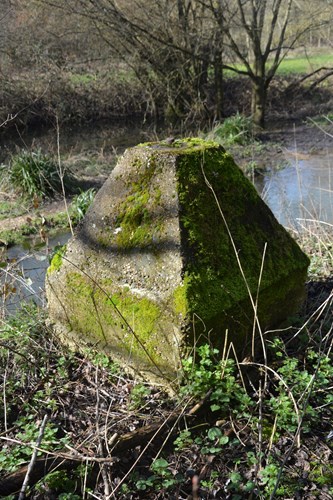
Sports in the park
Since its opening Victoria Park has hosted a wide range of sporting activities. The original park layout included a football pitch near the Hubert Fountain, three grass tennis courts at the south end of the park, and a cricket pavilion near the Christchurch Road entrance. The facilities were partially subsidised by the council and available to rent on a seasonal basis.
Works teams made up a large percentage of those renting sports facilities, including: South Eastern Gas Company’s Tennis Club, the Ashford Gas Board Cricket Club and the Ashford Allied Trade Unions who organised an annual sports day in the park. Sports facilities were also hired out to local schools, football clubs and church groups. Occasional one-off sporting events were held in the park, such as a sports day for children celebrating the Queen’s Coronation in 1953, a 48-hour badminton competition run by the Methodist Youth Club in 1969, and even donkey racing on Jemmett Road in 1954!
By the 1970s, the park had a football pitch, a cricket pitch, a putting green, two netball pitches and a total of five tennis courts (three grass and two hard). Work commenced on building a bowling green in 1973. Today, this is known as Ashford Indoor Bowls Club.
Although many sporting facilities have since disappeared from the park, there is still a multi-use games area where you can play basketball, netball (or perhaps race donkeys… you’ll have to bring your own though!)
Hoop rolling at Victoria Park, postcard, circa. early 20th century. Image courtesy of Melvin Roy Bartholomew.

